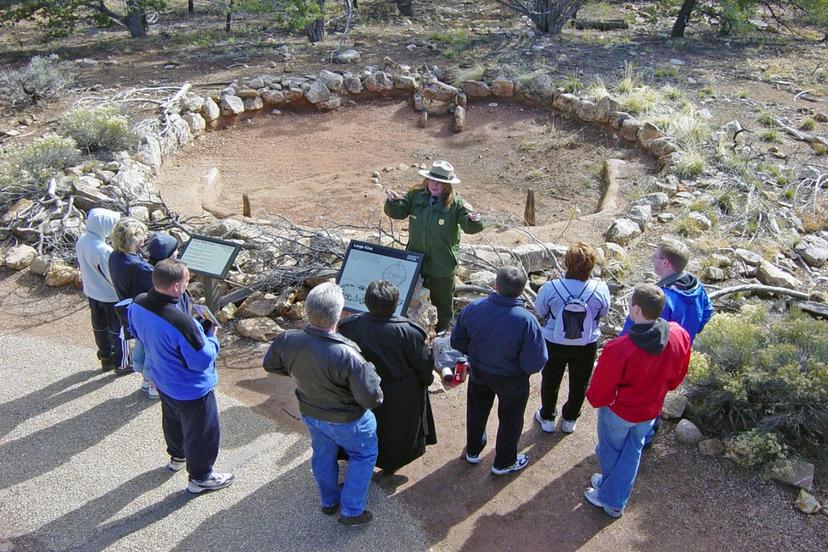Parks and Public Lands

Structure
Caring for our public lands is a big responsibility, especially when you consider that they presently comprise more than 13 percent of the United States. According to the U.S. Bureau of Land Management, public land covers about 245 million surface acres and 700 million sub-surface acres. The term public lands generally refers to land owned by the federal government, but parks can also be owned and/or managed by a municipality, county, or state government and is sometimes referred to as public land.
Title to federal public lands is held by various departments and agencies of the federal government. About 70 percent of the lands are managed by the Department of the Interior, whose BLM is by far the largest holding agency. Other Interior holding agencies are the National Park Service, Fish and Wildlife Service, Bureau of Reclamation, Geological Survey, and Bureau of Indian Affairs.
Second in acreage is the Department of Agriculture, whose Forest Service administers over about 193 million acres of U.S. land. The Departments of Defense and Commerce, the Tennessee Valley Authority, and other power agencies also hold public lands.
A primary principle of public land administration is to let the land be used for several purposes at the same time, such as grazing and mineral exploration, or conservation and recreation. Another guiding principle is to control the use of timber and other renewable resources, so that the supply remains constant.
There are hundreds of different jobs in parks and other public lands. The BLM alone lists more than 120 separate job titles, including safety and occupational health manager, public health program specialist, public affairs officer, archives specialist, financial analyst, land law examiner, park ranger, criminal investigator, game law enforcement officer, historian, archaeologist, and museum curator, to name a few.
With an annual budget of about $1.2 billion, the BLM employs about 9,000 permanent and almost 2,000 seasonal or temporary workers. Most of the land the BLM manages is located in the western United States. The BLM is headquartered in Washington, D.C., in the historic Department of the Interior Building. There are 12 state offices and field offices across the country in addition to the National Interagency Fire Center in Boise, Idaho; the National Operations Center in Denver, Colorado; and the National Training Center in Phoenix, Arizona. The mission of the BLM is to sustain "the health, diversity, and productivity of the public lands for the use and enjoyment of present and future generations."
Some employees work in the cultural resources area of the BLM. The bureau manages cultural resources identified in conjunction with proposed land transfers or disposals. For example, in 1997 the BLM funded archaeological studies of two prehistoric sites at the Jupiter Inlet Archaeological Site in Florida and at the Cave Creek Rock Shelter in Illinois. Cultural sites include scientific archaeological sites that are often open to the public. There are many active sites throughout the U.S., for example, studying Huobi Heritage, Mystery of the Mesa, and Calico Early Man site in California.
There are jobs in fire fighting at the BLM and other public agencies. In May 1997, prior to the wildfires that blackened large areas of Florida, the BLM's first prescribed (also known as planned) burn was successfully completed at the Jupiter Inlet Natural Area. This burn was accomplished cooperatively with Palm Beach County and the Florida Division of Forestry to restore habitat values for the threatened Florida scrub jay and a host of fire-dependent plant species. The BLM posts information as well as videos on its Web site about past and upcoming planned burns, https://www.blm.gov/programs/public-safety-and-fire/fire-and-aviation/regional-info/oregon-washington/prescribed-fire.
The National Interagency Fire Center (NIFC) is a good example of partnership among government agencies. The NIFC, located in Boise, Idaho, plays a key role in protecting public lands. The NIFC involves the BLM, National Park Service, Forest Service, Fire Administration, Fish and Wildlife Service, Bureau of Indian Affairs, National Association of State Foresters, National Oceanic and Atmospheric Association, National Weather Service, and Aviation Management Directorate. These agencies have pooled resources and personnel to protect the land and to respond to emergencies.
At state and city parks, the emphasis is often on developing specific land uses and programs to attract more visitors. Examples include community gardens, educational programs for children about nature and conservation, and group tours led by park staff members and volunteers. Because of this, workers at state and city parks are often more engaged in developing and implementing these kinds of programs, as well as promoting them in the local media.
